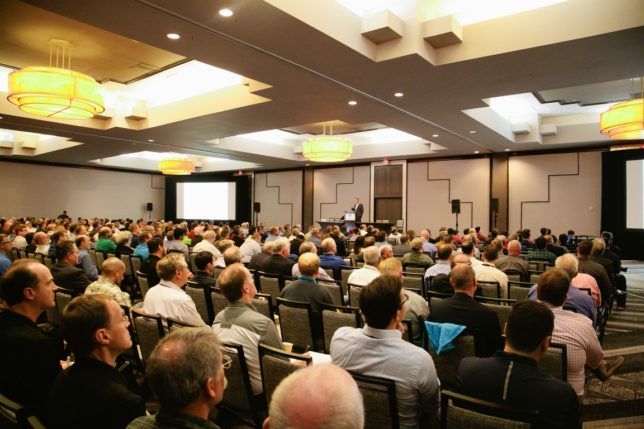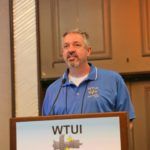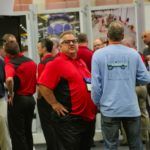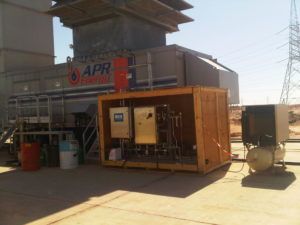TURBINE USERS ADDRESS RAPID CHANGE

TURBOMACHINERY OPERATORS ARE IMPACTED BY PRESSURE FROM
RENEWABLES, REGULATIONS AND DISTRIBUTED ENERGY RESOURCES
BY DREW ROBB
Power producers and oil & gas operators are being challenged by tough market conditions. Gas turbines (GTs) are being challenged to start faster and more often, operate with lower emissions, and have a lower power turndown and higher output, while staying reliable and being available.
The oil & gas industry, meanwhile, is slowly emerging from a period of historic low prices per barrel. Operators are forced to deploy turbomachinery under severe economic restraints. However, an abundance of U.S. shale oil and gas resources, and the beginning of LNG exports from the Gulf Coast hold promise for the future.
Companies such as GE, Air New Zealand Gas Turbine, MTU Power, TransCanada Turbine and IHI Japan, Strategic Power Systems, Orange Grove Energy, Acuren Group, Nova Scotia Power and the Turbine Inlet Cooling Association addressed these issues at the annual Western Turbine Users Inc. (WTUI) conference of March 2018 in Palm Springs, California.
As the largest aeroderivative GT user group gathering in the world, about 1,100 people gained insight into how to deal with rapid change, as well as best practices for turbomachinery maintenance.

Chuck Casey
Keynote
Chuck Casey, President of WTUI and the operator of a City of Riverside gas turbine plant in California, operates nine peakers—four are GE LM6000s. His plant has a combined cycle unit that also operates as a peaker due to shifts in the generation mix. His units only run at about 3% capacity.
He noted that the Federal Clean Power Plan (CPP) is mandating historic levels of renewable energy on the grid. This is causing coal and nuclear plants to be decommissioned simultaneously. Natural gas generation is also suffering in states such as California as wind and solar power are given priority. Increased subsidies for energy storage will put additional pressure on natural gas generation.
But all was not gloomy. Natural gas prices are maintaining a low range, amplifying the feasibility of GTs. “There is no doubt that social influence through government, social media and environmentalists is affecting us,” said Casey. “To stay relevant, you must fit your aeroderivative engines to be limber and flexible.”
Distributed energy resources (DER) are another factor. Customers are no longer happy just to have power. They are beginning to demand that their energy come from certain places. This is causing power producers to think and act differently.
Casey gave the example of a joint Southern California Edison, GE and Wellhead project to create a battery-gas turbine hybrid system in Norwalk, California. The LM6000 Hybrid Electric Gas Turbine (Hybrid EGT) offers quick start, and fast ramping capabilities to support SCE’s growing renewable portfolio. A 10 MW battery energy storage system works in conjunction with a 50 MW LM6000 aeroderivative gas turbine. California has committed to derive 50% of its electricity from renewable sources by 2030. The Hybrid EGT helps balance variable energy supply and demand, during day and evening hours. The control system blends output between the battery and the gas turbine. It allows enough time for the GT to start and reach its designated output. There is no need to burn fuel while keeping the turbine on standby.
Demineralized water consumption is reduced by 45% at the plant. Casey said the LM6000 in this hybrid example is basically providing a new form of spinning reserve. Statistics from the Energy Information Administration (EIA) were also cited. Out of 25 GW of utility-scale electric generating capacity added to the grid during 2017, nearly half use renewable technologies. Another 3.5 GW of small-scale solar net capacity additions came online in 2017. More than half of the renewables came online during the fourth quarter.
Renewable capacity additions are often highest in the final months of the year to qualify for federal, state or local tax incentives. In early spring, California’s total solar share of gross electricity demand exceeded 50% during the mid-day hours. This resulted in negative pricing. The state paid its neighbors to take the power off its hands. In 2017, U.S. monthly electricity generation from wind and solar exceeded 10% of total U.S. electricity generation for the first time.
Casey acknowledged the problem, but believes the industry can adjust, and that it can find its place in the future energy mix. He noted that coal generation is down from 50% of U.S. electric generation to less than 30% over the past 12 years. During that same period, natural gas has risen from 20% to 33%.
“For the third consecutive summer natural gas beat coal as an electricity generating source,” he said.
Depot briefings
Four major GE-authorized vendors offer aeroderivative turbine services: Air New Zealand Gas Turbine (ANZGT), MTU Power, TransCanada Turbine (TCT) and IHI Japan. ANZGT kicked off the depot briefings. With GE having ended support for the LM5000, it falls mainly on ANZGT to serve the small user base that remains: ten units in Europe, one in the Middle East, two in Latin American, nineteen in North American and one in Asia.
Beyond its work on the LM5000, ANZGT considers the LM2500 to be the mainstay of its business. IHI is involved in more than GTs. It also serves the boiler, Heat Recovery Steam Generator (HRSG), air quality control system, and gas process storage markets. On the GT side, it focuses on the LM6000. IHI offers is own packages and controls, as well as conducting field and depot maintenance. It has a Cheyenne Service Center in Wyoming (a Level II facility), as well as Kansas, Chicago, Houston and Southern California branches.
MTU Power is the new name of a company that used to be known as MTU Maintenance. It services commercial aircraft, military jet engines, aeroderivative GTs and industrial GTs. It has a Level II service shop in Dallas, TX. But its premier facility is its Berlin Level IV shop. It can service the entire LM range of engines, including the LM5000. More than a change of name to MTU Power, this move consolidated the existing GT engineering, manufacturing and aftermarket expertise and services from three business units: Aero Solutions, Brush Seals and MTU Maintenance. Aero Solutions specializes in development, testing, design optimization and manufacturing of turbines and compressors for original equipment manufacturers.
In addition, MTU has a brush seals team. Brush seals are made up of thousands of thin bristles fixed together using core wire and a clamping tube to form a flexible seal. This method is said to outperform conventional sealing systems, such as labyrinth seals.
TCT works mainly on the LM6000 and LM2500, as well as the Siemens RB211 and Avon (formerly Rolls-Royce). Its parent companies are Wood Group and TransCanada. Headquartered in Airdrie, Calgary, it operates four Level II shops: Bakersfield, Houston, Syracuse and one in Glasgow, UK.
Scott Strazik, President and CEO of GE Power Systems followed with a bullish briefing about the evolving aeroderivatives marketplace. Strazik stressed that aeroderivative GTs remained “incredibly important for us,” naming them a priority market for GE going forward. Strazik believes market forces are transforming the industry.
The California duck curve (a sharp falloff of renewable power in the afternoon) is taking place now in Hawaii and Texas. “Aeroderivative gas turbines need to be positioned correctly in the market,” said Strazik. “We need to provide machines with faster ramp rates and that are comfortable with more starts. Ancillary services will be given a bigger role, including the management of emissions and providing spinning reserve.”

Breakout sessions
Attendees to WTUI are offered extensive breakout tracks for users of the LM2500, LM5000, LM6000 and LMS100. They consist of several days of in-depth briefing, review and Q and A on details of machine performance and maintenance. This year, Turbomachinery International sat in on some LM2500 sessions.
Despite being about fifty years old, the LM2500 was the highest selling aeroderivative engine of 2017. The LM2500 evolved from the CF6 aircraft engine, which has 490 million running hours. Over the decades, it has earned a reputation for dependability, with over 93 million total fleet hours. Several versions of the machine are available:
• The LM2500+4 provides up to 34.3 MW at 38.4% efficiency, with 562 units sold
• The LM2500+ provides up to 31.3 MW at 38% efficiency, with 732 units sold
• The original LM 2500 provides up to 23.8 MW at 35.9% efficiency, with 1,174 units sold. Overall, more than 2,460 units have been shipped by GE. While most are deployed in Europe and North America, they can be found all over the world. Two combustor versions are available:
• Single Annular Combustor (SAC) units, with 1,767 in operation, the first sale taking place in 1969
• Dry Low Emissions (DLE) LM2500 first sold in 1992. Some 701 units are in use with this combustor.
The LM2500 track consisted of briefings from GE and depot personnel about the status of known maintenance issues, performance numbers from Strategic Power Systems (SPS), and user Q and As, which delved into various problems and fixes. GE representatives briefed the crowd on various fixes for their engines. This included how to address problems with variable stator vane (VSV) turnbuckle wear on the LM2500+G4 high pressure compressor (HPC). Wear is caused by metal-to-metal contact between the turnbuckle and clevis walls due to misalignment. GE has come up with a fix that includes a washer than prevents contact, as well as anti-rotation links to dampen turnbuckle rotation. Premixer shroud oxidation was found on two engines. This was noted by the presence of elongated fuel discharge holes and distress at the pigtail/premixer flange. The causes were on-off cycles being near maximum power, and backflow of combustor air near the premixer resulting in auto-ignition. The GE solution was to place tunable switches in the control software to prevent cycling of the fuel flow.
WTUI showcased GE’s entire range of aeroderivative gas turbines including the LM2500, LM5000, LM6000 and LMS100. GE showcased several other active engine programs for the LM2500 dealing with the DLE gas manifolds, the high-pressure turbine (HPT) Stage 1 and 2 blades and bearing improvements. Ruptures to the DLE gas fuel hose were noted after units that had been running on liquid were switched to gas. During extended liquid fuel operation, water can accumulate in the gas manifolds in moist environments. Rapid evaporation of water to steam can over-pressurize the gas hose. Heavy hydrocarbon condensation in the gas hose and subsequent auto ignition with combustor air contributed to one event. Enhancements from GE include check valves to prevent pre-mixer to pre-mixer cross-talk and eliminate the water source. HPT Stage 1 blade oxidation was found in some LM2500+G4s, especially at the trailing edge near the mid-span location. This was more pronounced in SAC applications, causing early blade removal and higher scrap rate at overhaul.
Enhancements introduced by GE included changing the thermal barrier coating (TBC) process to minimize variation. The OEM is evaluating a more capable bond coat for SAC applications. A new casting design is also being introduced in 2019 to improve durability. Meanwhile, GE recommended that users conduct regular borescope investigations on the hot section.
GE chose WTUI to promote several other technologies. It is promoting a clutchless synchronous condensing approach to provide reactive power to the grid due to the increased presence of renewable energy. This is done via an LM2500 control system upgrade, which allows the generator to provide frequency and reactive power support to the grid. It requires the addition of a sump evacuation system, and Woodward MicroNet+, GE Mark Vie or Woodward Flex500 controls. GE’s latest SAC control upgrade is said to reduce certain trip events and may help increase power reliability. It takes advantage of Woodward Flex500 controls.
Additionally, an upgrade is available from SAC or DLE 1.0 to the DLE 1.5 (a triple annual combustor with new gas manifolds and gas metering system). This new combustor burns fuel at a lower temperature over a larger cross-sectional area to achieve the same bulk gas temperature rise as a single set of nozzles burning a higher core temperature. Gas fuel is introduced into the combustor through 75 air/gas premixers. This helps to lower emissions.
The LM2500 track began with Bob Steele, Vice President of Systems and Infrastructure at SPS. He detailed Operational Reliability Analysis Program (ORAP) numbers. ORAP captures data from global operating power plants (gas, steam and wind) as well as reciprocating engines. Steele detailed the LM2500 fleet numbers. This enables turbine owners and operators to compare the performance of their own equipment. For a simple cycle plant, the fleet average for 2017 was 92.8% availability.
When operating as peakers, that rises to 97.3%, and when cycling, at 93.7% and baseload, at 92.4%. Overall, availability was down 1% from 2016. Steele said this was due to other balance of plant (BOP) equipment outages at some plants. Every year, SPS provides a rundown of the causes of outages. Some 88% of the forced outage hours in 2017 were due to station (BOP) equipment. For example, there were many incidents related to gas fuel supply caused by low gas pressure or supply problems.
Other problem areas, said Steele, were controls and communication systems going down, difficult environmental conditions (such as icing), instrumentation and grid instability. These were among the leading causes of forced outages on the LM2500. Specific to mechanical drive, outage sources included pipeline instability, antisurge, gas seal leaks and outlet temperature. Power turbine-based downtime, on the other hand, was traced to areas, such as vibration trips and combustion system issues (due to flameouts and acoustic incidents). This is just a smattering of the extensive performance and downtime data SPS provided to LM2500 users. Those enrolled in the ORAP program gain full access to all fleet-wide statistics.
There comes a point in the WTUI user tracks when OEMs and vendors are asked to leave the room. This allows users to have an unrestrained discussion about the various problems they face with their own engines. Many of the other users pitch in with how they addressed those issues. Over several days, users took up a long list of operations and maintenance topics.

Fog skid deployed at APR Energy site on Pratt and Whitney FT8 MobilePac gas turbine in Libya. Courtesy of Mee Industries
The discussion was moderated by Garry Grimwade, Chair of the LM2500 track, and Utilities Generation Technician at Riverside Public Utilities. He took up speed transducer failure in the power turbine. This, he said, set off multiple vibration alarms, as well as an alarm that a sensor had failed. After checking the Bently Nevada 3500 system on his LM2500 to find the vibration issues, he isolated the fact that a faulty transducer made it look like vibration trouble. He recommended that users experiencing the same problem replace the transducer themselves without the need to call in an authorized service provider.
Grimwade took up other areas, such as combustor and hot section damage, borescope inspections, cracking of the combustor, and liberation of metal causing damage to the HPT. In his case, the second stage blade needed replaced. He advised users to look frequently in this area for possible damage and added that water injection LM2500 engines were the ones primarily suffering from this problem.
“The high flow of water causes rapid thermal expansion,” said Grimwade. “GE is looking into this and helping users resolve any issues.”
Technical sessions
Technical sessions kicked off with Dean Webb, Combustion Turbine Reliability Specialist at Nova Scotia Power, covering predictive maintenance and asset management. He looks after seven Pratt & Whitney (PW) GG4Cs. Six are in active service and the other is being restored to service. Despite their age, the utility believes the inventory of available spare parts should keep them running for a while longer. They are being used for synchronous condensing and peaking.
In addition, Nova Scotia Power has two LM6000 PCs as well as a spare engine. Over the past 15 years, there have been around 14 LM engine removals. These machines are used for baseload and for load following. “Even with monitoring and predictive maintenance, you still need operational surveillance,” said Webb.
Webb does non-destructive testing (NDT), vibration analysis, oil analysis and regular health assessments. Critical for borescope inspections, he said, is intimate knowledge of the equipment. The operator must have a keen sense of spatial orientation to be able to visualize the location of the probe tip. His company conducts borescopes during scheduled annual outages, as well as during some forced outages.
He gave an example of an impending vane liberation on HPC Stage 10 stator in a PW unit. No vibration or performance indications were observed. Yet the borescope found the problem in an area that was not easy area to get into due to the unit having very few ports of entry.
“We noticed the worn disc, that the stator vanes had liberated and were being pulled into the disk,” said Webb. “They were on verge of falling out and could have caused damage.”
Another issue: The LPC Stage 0 has suffered a soft-body impact. The operator noticed a change in sound emitted from an area adjacent to the inlet volute, as well as a shift in vibration. A borescope inspection determined that a blade was out of alignment. This was traced to icing related to the leak in the SPRINT water injection system. A five-centimeter ball of ice caused the damage to the blade.
“We experienced no trips, but we found the problem early enough due to vibration analysis and borescope inspection,” said Webb.
Oil analysis is another tool used by Nova Scotia Power. This proved to be of assistance with a starter problem. Debris found in the oil was due to wear in the oil wetted system.
Matthew Holmes, Senior Reliability Engineer at Acuren Group, assisted Nova Scotia Power with this investigation. Oil analysis targeted contaminants, wear metals, additives, viscosity, water presence, acidity, particulate and varnish. “This helps us understand if there is bearing degradation,” said Holmes. “Vanadium indicates a main bearing issue in the LM6000. You can also check the filters and analyze the debris. That provides an indication of wear and other issues.”
In addition, Acuren helped the utility with vibration monitoring on the LM6000. More sensors were added as the LM6000 has only a few sensors for vibration analysis. The regular sensors failed to detect any problems. But the added sensors picked up vibration problems. “
We looked in the engine and found the LP rotor blades to be out of alignment as a blade that had gone into the casing,” said Holmes. “The cause was LP rotor unbalance.”
He recommended installing more sensors, establishing baselines and then monitoring for changes in vibration. Several sensors should be added to the compressor, gear box and bearings. It is a good idea, then, to combine several analysis technologies as well as borescope inspections to make informed maintenance decisions, said Holmes. Monitoring the oil sump for metallic particles, for example, yielded information about a bearing failure in a gearbox. Air quality affects the entire engine due to the sump pressurization air circuits, component cooling and recoup air circuits, added Webb.
Poor air quality can accelerate corrosion, affect coatings, lessen component cooling and degrade performance due to compressor fouling. Similarly, water quality affects the hot section of the engine. Off-spec SPRINT spray patterns, for example, may impact TBCs, cause pitting and lead to gypsum build.
Emissions control John Hutson, Plant Manager for Orange Grove Energy (OGE) outlined an emissions control improvement project. His 98.5 MW plant, which began operation in 2010, has two simple cycle LM6000 PC SPRINT units. Mechanical inlet chilling is done with the inlet temperature kept in the range of 46 to 86°F.
Further, the units use Woodward controls, have fuel gas compression, and use water injection for emissions control. Due to its location in the desert climate of Northern San Diego County, California, and state restrictions on water usage, 100% of the facility’s water is trucked in. It is demineralized on site. Emissions controls include a back-end CO catalyst that keeps CO below 6.0 ppm and an SCR system to keep NOx below 2.5 ppm. NOx emissions are also keep down via water injection.
“We have no margin for error due to stringent emissions regulations that make compliance a continual battle,” said Hudson. In such a regulatory environment, the facility pays attention to the small details. For example, it addressed poor thermal control of the outer exhaust liner. This impacted ammonia control, which was too slow to properly control NOx at full load.
As the plant skated dangerously close to exceeding its air permits, this limited options to increase power output. The solution included an ammonia control logic upgrade, a remodeled exhaust plenum, and better SCR and CO catalyst operation.
Inlet cooling
Dharam Punwani, Executive Director of the Turbine Inlet Cooling Association. (TICA), gave an overview of inlet cooling technologies. He covered the fundamentals: An increase in ambient temperature reduces the generation capacity and efficiency of GTs (up to 19% capacity loss and 4% efficiency loss for an aeroderivative). That is why U.S. generation capacity is significantly lower than nameplate capacity; fuel use and CO2 emissions increase during peak demand in summer due to the use less efficient systems to meet demand.
“The solution is to cool or chill the air before it goes into the compressor section using proven technologies, such as evaporation cooling, fogging, wet compression and chilling,” said Punwani. “Thousands of plants are using these methods: each technology has its pros and cons.”
Wetted media evaporative cooling is the least capital cost. Fogging is slightly more costly but generally produces more cooling than wetted media. Further, it can be augmented with wet compression. Fogging also has a low parasitic load. Chillers may be the most expensive, but they are more effective in terms of the amount of cooling and capacity enhancement that can be accomplished, independent of the humidity — down to 42°F (any lower could lead to icing).
The parasitic load, though, is higher. He explained that technology selection is site-specific. It depends on many factors: market value of electricity, weather data, fuel cost and anticipated payback period. He ended with examples of recent (2015- 2017) installations of all technologies. The WTUI show will return to Las Vegas in March of 2019.